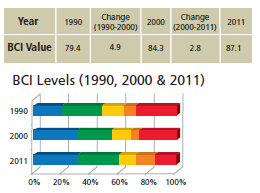BCI Trends, 1990 to 2011 – Slowing Down
The global BCI has progressed between 1990 and 2011, although, in general, there is slower rate of progress between 2000 and 2011 than between 1990 and 2000. In 1990, the average BCI value (population weighted) for countries with available data was 79.4. In 2000, BCI increased by 4.9 points to 84.3. BCI further increased to 87.1 by 2011, but at a lower increment of 2.8 points – lower than the increment posted in the previous decade.
Global BCI Trend, 1990-2011

Looking at the regional trends, it is noted that in the past 20 years from 1990 to 2011, more countries have achieved basic and medium BCI levels. During the same period, the number of countries with critical BCI level has decreased from 42 countries in 1990 to only 28 by 2011. Some of these countries advanced to the next level while a few have actually moved two levels higher.
The number of countries with medium BCI levels increased from 44 in 1990 to 52 in 2011. Countries that have scaled up their BCI levels from low/very low to medium include the following: Algeria, Iran, Kuwait, Saudi Arabia, Syria and Tunisia (Middle East and North Africa); Azerbaijan, Tajikistan, Maldives and Vietnam (Central, South and East Asia); and Belize, Brazil, Colombia, El Salvador, Mexico, Paraguay, Peru and Suriname (Latin America). El Salvador registered the highest increment in BCI in this group accounting for a 17 point increase for the period 1990 to 2011. In contrast, countries such as Ukraine, Bosnia and Herzegovina, and Thailand have moved down from basic BCI to medium level.
Nineteen (19) countries registered low BCI levels in 2011. Countries such as Bolivia, Honduras and Nicaragua in Latin America, and Cape Verde, Zimbabwe, and Swaziland in the Sub-Saharan Africa region, improved their standing from very low/critic BCI level to low BCI. Within this group of countries that registered low BCI levels, Bhutan in South Asia recorded the highest increase of 28 points, climbing up from critical to low BCI level.
The number of countries in the critical BCI list has declined since 1990 to only 28 by 2011. Countries such as Benin, Cameroon, Eritrea, Ghana, Kenya, Malawi, Rwanda, Tanzania and Togo in Sub-Saharan Africa; Guatemala in Latin America; Djibouti, Egypt, Morocco and Yemen in the Middle East and North Africa; Laos and Myanmar in East Asia; and Bhutan and India in South Asia, have moved up from their previous critical BCI levels. Nonetheless, the number of countries in the critical list remains substantial especially if one considers that many poor countries with no reliable data collection system, indicating poor functioning institutions, would more likely fall in the critical BCI levels.


